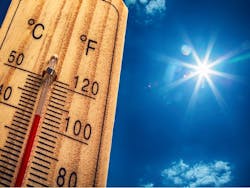How Many Hours-of-Safety before Buildings become Dangerous in Extreme Heat?
Microgrids and other distributed energy resources can extend a buildings “hours-of-safety” — a concept explained here by Rocky Mountain Institute (RMI) authors Jacob Corvidae and Sneha Ayyagari.
How many people in your community are at risk during extreme weather events? The heat waves wracking the nation right now can cause heat exhaustion, heatstroke, dehydration, and even death. Last year over 90 people died in Quebec (over 50 in Montreal) due to a heat wave. And during Chicago’s famous 1995 heat wave over 700 people died. When the power goes out — which often happens with extreme temperatures — the problem becomes dramatically larger. With fans, air conditioners, and refrigerators unable to provide any relief, the question is clear: how long can a home maintain the last comfortable temperature it had before conditions inside the home match the extreme conditions outside the home? This is what we’re calling hours-of-safety, which can determine the difference between safety and danger.
Critical hours to understand
The difference between 20 hours of safe and comfortable in-home temperatures and only 5 hours could be the difference between life and death for vulnerable populations. It makes the difference between staving off heatstroke until the power is returned, allowing time for family or neighbors to arrive and provide support, or buying time to evacuate.
We need to understand our homes in terms of the hours-of-safety they can provide when the power goes out to reduce the amount of time people are exposed to extremely hot or cold temperatures.
While there has been considerable work to define metrics for the resilience of the electricity grid, there has been little work done on how long buildings are able to maintain healthy temperature levels. Homes vary widely in their ability to maintain comfort during these events, and we need to start making our homes better prepared. Fortunately, making homes more efficient and safer can be accomplished while providing other benefits such as lower energy bills.
The Growth of extreme weather events
Today we’re seeing extreme temperatures happening more frequently across the country, and the magnitude and frequency of extreme weather events will only grow over time. The National Resource Defense Council (NRDC) projects that by 2100 the United States will experience almost 30,000 heat-related deaths every year if current levels of carbon dioxide emissions persist.
This past weekend, 50,000 New York city customers lost power, and 6,000 still did not have power more than 24 hours later. In 2016, outages tended to average around four hours during major events, and in some states between 8 and 20 hours—and that’s the average, meaning some events last longer. Between January and June 2019, over 2.9 million customers were out of power for a total of 684 hours as a result of outages caused by severe weather.
Extreme temperatures are particularly a problem for lower-income housing, vulnerable populations, and people living in social isolation. This is exacerbated by the fact that low-income housing is often poorly insulated and very drafty.
RMI’s Jacob Corvidae
Hours-of-safety is just as relevant during cold weather events as during heat waves: when it’s hot outside leaky and poorly insulated homes can’t keep out the heat; when it’s cold outside, they can’t keep out the cold. This past winter many regions were struggling with polar vortex after polar vortex that hammered communities with extreme cold conditions. As temperatures plunged in the Midwest this past winter up to negative 31 degrees, at least 21 people died and many more were affected by frostbite and hypothermia. Thus, hours of safety is a year-round problem.
Smart building strategies can make a difference
City governments and other policymakers should consider how to support better community resilience and safety by addressing this need. Fortunately, the building industry can play a role in equipping our cities to be more resilient against extreme heat and cold through a variety of strategies. The Resilient Design Institute defines passive survivability as “a building’s ability to maintain livable conditions when sources such as electricity, water, or heating fuel are cut off.” Considering hours-of-safety can help improve the passive survivability of a building and can help save lives. The main thing that determines how many hours-of-safety a home has in extreme weather power outages comes down to two things: how well insulated the home is and how much air leakage the home has between the inside and the outside.
RMI’s Sneha Ayyagari
Passive design strategies such as a tighter envelope and more insulation can also help make buildings more efficient and resilient in both cold and hot temperatures. Implementing features such as cool roofs and thicker walls can contribute to buildings that stay comfortable for longer in the event of a power outage. A study from Passive House Institute US found that lower window-to-wall ratios and natural ventilation are helpful in maintaining favorable conditions during summer outages. In warm climates, simple changes such as adding white paint could lower roof temperatures by as much as 30°C or 86°F and indoor temperatures by 3.6°F to 9°F. Having thick walls can help buildings maintain moderate indoor temperatures. For example, residents of Brooklyn living in a house with highly insulated walls maintained an indoor temperature of around 60°F–72°F although outside temperatures dropped to almost 0°F in the 2014 Polar Vortex.
A more efficient building envelope can be combined with other resilient design strategies such as islandable solar PV systems and battery storage that can keep systems going during power outages even at times when the sun isn’t shining.
These components provide a significant added value during extreme weather events that will only become more common over the next century. Society needs a way to consider that value alongside energy cost savings. This will help us understand if our buildings are prepared for the extreme weather events that are unfortunately becoming more frequent. Understanding the hours-of-safety that our homes provide can give us piece of mind or at least clear parameters on how we need to respond to emergencies.
Jacob Corvidae and Sneha Ayyagari work in the RMI Buildings Practice. Their blog originally appeared in RMI’s website and was reposted with permission.







